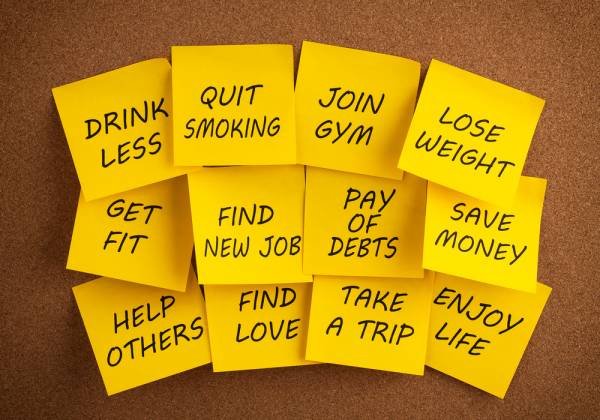A new year equals a new you, right? Well, not exactly. According to Forbes writer Dan Diamond, nearly forty percent of Americans make New Year’s resolutions, but only eight percent of Americans are successful at achieving or keeping those resolutions.
The intent of this article is threefold:
A new year equals a new you, right? Well, not exactly. According to Forbes writer Dan Diamond, nearly forty percent of Americans make New Year’s resolutions, but only eight percent of Americans are successful at achieving or keeping those resolutions.
The intent of this article is threefold:
- To understand why New Year’s resolutions fail and avoid making resolution mistakes.
- To understand the mindset necessary to successfully achieve your resolution.
- To implement the steps needed to be part of the eight percent who reach their New Year’s goals.
A Brief History of Resolutions
You can blame the whole thing on the Romans. New Year’s resolutions date back to 153 B.C., when Janus, a mythical king of early Rome, was placed at the head of the calendar. Janus’ two faces could look back on past events and forward to the future.
A bust of the Roman god of transitions, Janus
King Janus soon became the symbol for resolutions and many Romans used this time of year to seek forgiveness from their enemies (for past events) and exchange gifts (for future goodwill).
Over time, this practice transformed into making personal reflections on the past and changing personal behaviors to positively affect the future.
Waiting to Change Until the New Year
According to John Norcross, a researcher for the Journal of Clinical Psychology, the most popular New Year’s resolutions are weight loss, exercise, quitting smoking, better money management, and debt reduction.
All good resolutions, but why wait until January first to implement the change?
“Reset your thought process, remind yourself why you made the resolution, change the behavior or habit, and consider what you have to gain by achieving your goal.”
Timothy Pychyl, a psychology professor at Carleton University, stated that resolutions are a form of “cultural procrastination,” as well as an attempt to reinvent oneself. By waiting for January, people excuse their yearlong behaviors and habits and allow the reinvention to wait until the New Year.
RELATED: A New Kind of Resolution for 2015
Why Do People Fail to Keep Resolutions?
Psychologists have discovered the excuse of “I have no will power” is just that – an excuse.
In a study conducted by Stanford University, psychologists gauged whether or not people believed they had willpower and then tried to convince people the opposite of what they believed. Those who believed they had will power had to be convinced they did not, and those who believed they did not have will power had to be convinced they did.
“Setbacks happen. While the above steps and recommendations sound easy, remember only eight percent of people attain their resolutions. Be flexible and keep trying.”
The researchers found the person’s original mindset overrode all attempts of psychologists to convince him or her otherwise. So, a person stating he or she has will power has already set the stage for successfully achieving a resolution.
Conversely, a person stating he or she has no will power has already made the excuse and laid the foundation for failure.

Similarly, psychology professor Peter Herman expresses his resolution theory as the “false hope syndrome.” Meaning, the resolution is unrealistic and beyond the person’s emotional, spiritual, physical, or mental ability. Again, the person is mentally setting the foundation for failure, as the goal is beyond the person’s capability.
If the resolution is not founded in a person’s positive sense of self, then the resolution will not work.
RELATED: The 3-Step Way to Create Lasting Habits
The Science of Habit and Change
According to neuroscientists Antonio Damasio and Joseph LeDoux and psychotherapist Stephen Hayes, habitual behavior is created by thinking patterns that create neural pathways and the automatic fallback response for a person’s behavior or thinking pattern when faced with a choice or decision.
Change requires creating new neural pathways for new thinking. Recent neuroscience research shows the brain works in a protective way and is resistant to change. The research further shows any goals that require substantial behavioral or thinking pattern changes will automatically be resisted.
The brain is wired to seek rewards and avoid pain, discomfort, and fear. When fear of failure invades a person’s mindset, the person becomes demotivated, triggering an automatic response to return to known behaviors and thought patterns. This is how resolutions fail.
RELATED: 10 Pointers for Making More Powerful Resolutions
Making resolutions work means changing behaviors and habits, but the brain needs to be rewired first. Prior to changing a behavior or habit, you must first change the thought process regarding your behavior or habit. According to Dalasi, LeDoux, and Hayes, you can take the following steps to help change behaviors and habits:
- Focus your thinking on new behaviors and thought patterns. You have to create new neural pathways in your brain to change habits.
- Focus on the present. What can you do today, right now, to help achieve your goal?
- Be mindful. Become physically, emotionally, spiritually, and mentally aware of your inner self as each external event happens, rather than living in the past or future.
As our mindset changes, and as we begin to change our behaviors and habits, we can think about our resolutions and goals. How can you positively attain the changes you seek in your life?
“If the resolution is not founded in a person’s positive sense of self, then the resolution will not work.”
- Be specific about your resolution. Make realistic, measurable goals, and write them down.
- Limit the number of resolutions you make.
- Post your list in a visible place to serve as a reminder and to encourage yourself.
- Enlist the support of your friends and family.
- Take action immediately. Make appointments with a doctor, dietitian, or counselor. Sign up for a gym membership or buy any necessary equipment.
- Practice the new behaviors that will encourage your success. Want to stop smoking? Don’t hang out in smoking areas. Want to eat healthy? Don’t bring desserts, junk food, candy, or ice cream into the house.
- Seek a support group. Limit your exposure to people likely to encourage resolution breaking. Surround yourself with good, supportive friends, not people who sabotage or belittle your efforts.
- Set incremental goals and reward yourself for partial successes. Ran your first 5K? Treat yourself to a new fitness outfit. Lost the first five pounds? Celebrate with a massage.
- Substitute a good habit for the bad one you want to break. If your goal is to eat less junk food, find a healthy food you love. If you want to spend more time with your family, establish a special time during the week when everyone is together.
THERE’S AN APP FOR THAT: The 7 Best Apps for Changing Your Fitness Habits

Improve Your Flexibility
Setbacks happen. While the above steps and recommendations sound easy, remember only eight percent of people attain their resolutions.
Be flexible and keep trying. Rewrite your resolutions or break your resolution down into smaller steps. Look at your setback as a learning process, rather than a failure, in reaching your goals.
Reset your thought process, remind yourself why you made the resolution, change the behavior or habit, and consider what you have to gain by achieving your goal.
Be that eight percent that succeeds in reaching your New Year’s resolution. Happy New Year!
References:
1. Diamond, Dan. “Just 8% of People Achieve Their New Year’s Resolution. Here’s How They Did it”. Accessed December 16, 2014.
2. Gordon, Marilyn. “Train Your Brain To Let Go Of Habits – 10 Methods For Creating New Neural Pathways”. Accessed December 16, 2014.
3. “Why Do People Make New Year’s Resolutions?” Accessed December 16, 2014.
4. Williams, Ray B. “Why New Year’s Resolutions Fail,” Accessed December 15, 2014. 5. Williams, Ray B. “Why Setting Goals Can Do More Harm Than Good,” Accessed December 15, 2014.
Photo 1 courtesy of Wikipedia.
Photos 2, 3, and 4 courtesy of Shutterstock.






